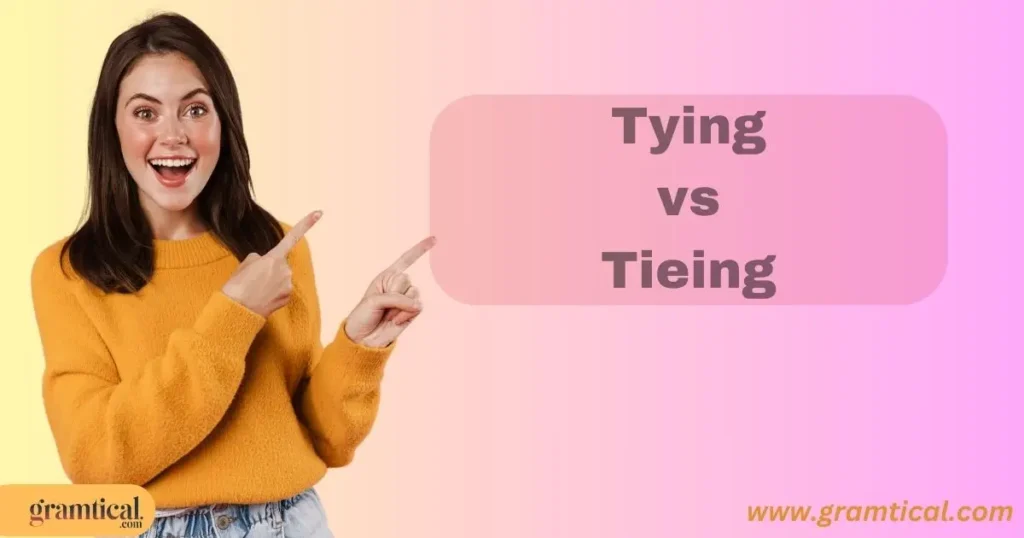- 1. Understanding “Tying vs. Tieing”
- 2. How to Use “Tying vs. Tieing” Correctly
- Privilege vs. Priviledge: Which is Correct?
- 3. Common Mistakes and How to Avoid Them About “Tying vs. Tieing”
- 4. A Comparison of “Tying vs. Tieing”
- 5. What’s the Difference Between “Tying vs. Tieing”?
- 6. A Quick Comparison Table About “Tying vs. Tieing”
- 7. Why Does This Matter?
- 8. Practical Exercises for “Tying vs. Tieing”
- FAQs
- Is “tying” the same as “tieing”?
- Why does “tie” change to “tying”? The “-ie” in “tie” changes to “y” before adding “-ing” to follow English grammar rules.
- Can “tieing” ever be correct? No, “tieing” is not considered correct in standard English.
- What are some examples of “tying”?
- Why is spelling important? Correct spelling enhances clarity and avoids miscommunication.
- Conclusion
“Ever wondered which is correct: ‘tying’ or ‘tieing’? Let’s untangle the confusion.”
Language can be tricky, and even native speakers sometimes hesitate when it comes to spelling certain words.
One such case is the confusion between “tying” and “tieing”. While both seem plausible, only one is the correct spelling and understanding the distinction matters for effective communication.
In this article, we’ll dive into the correct usage of “tying” vs. “tieing”, exploring their definitions, contexts, and how to avoid common mistakes.
This isn’t just a lesson in spelling but also a guide to understanding the nuances of English.
Let’s clear up this confusion once and for all with examples, comparisons, and practical tips that ensure you use the right term in every situation.
1. Understanding “Tying vs. Tieing”
To start, let’s address the core question: Which is correct—“tying” or “tieing”?
The correct form is “tying”, which is the present participle of the verb “tie.” For instance:
- Correct: She is tying her shoelaces.
- Incorrect: She is tieing her shoelaces.
The word “tying” follows standard English grammar rules for verbs ending in “-ie.” When adding the suffix “-ing,” the “-ie” changes to “y.”
For example:
- Die → Dying
- Lie → Lying
- Tie → Tying
A conversation example might go like this:
Person A: “Are you tieing the ribbon?”
Person B: “Actually, it’s ‘tying’ the ribbon. ‘Tieing’ isn’t correct.”
This rule applies universally, so whether you’re writing about a physical action like tying knots or a metaphorical idea, “tying” is always the correct choice.
2. How to Use “Tying vs. Tieing” Correctly

Explanation:
“Tying” is used when describing the act of fastening or securing something. It can refer to physical objects, such as shoelaces, or abstract concepts, like tying together ideas. “Tieing” is a common misspelling and should be avoided.
Scenario Example:
Imagine you’re emailing a colleague about project updates. Which sentence looks professional?
- Incorrect: I am tieing the loose ends of the report.
- Correct: I am tying the loose ends of the report.
Email Example:
Subject: Project Update
Hi Sarah,
I wanted to inform you that I’m currently tying up the final details for the presentation. Let me know if you’d like me to review anything before submission.
Explanation:
In this example, “tying up” refers to finalizing or completing tasks, showcasing the versatility of the word.
Privilege vs. Priviledge: Which is Correct?
3. Common Mistakes and How to Avoid Them About “Tying vs. Tieing”
Many people mistakenly use “tieing” because it seems like a natural extension of the root word “tie.” However, it’s important to remember the spelling rule for verbs ending in “-ie.”
Here are three common mistakes to avoid:
- Typing Errors:
- Incorrect: He was tieing the boat to the dock.
- Correct: He was tying the boat to the dock.
- Misinterpretation of Rules:
- Some learners assume all verbs simply add “-ing” without adjustment. Remember the “-ie” to “y” rule.
- Informal Writing Habits:
- Incorrect spellings often slip through casual communication. Proofread to ensure accuracy.
4. A Comparison of “Tying vs. Tieing”
Here are three examples illustrating the difference:
- Tying (Correct):
- The fisherman is tying a knot.
- Meaning: Fastening something securely.
- Tieing (Incorrect):
- The fisherman is tieing a knot.
- Explanation: This spelling is grammatically incorrect.
- Tying (Abstract Use):
- She is tying her achievements to hard work.
- Meaning: Connecting concepts metaphorically.
5. What’s the Difference Between “Tying vs. Tieing”?
The primary difference lies in correctness:
- Tying is grammatically accurate and adheres to standard English spelling rules.
- Tieing is a misspelling and should be avoided.
Examples:
- He is tying his tie before the meeting.
- She enjoys tying bows for her handmade gifts.
- The artist is tying different themes together in her painting.
6. A Quick Comparison Table About “Tying vs. Tieing”
|
Word |
Meaning |
Example |
|
Tying |
Securing or connecting something |
She is tying her hair in a ponytail. |
|
Tieing |
Incorrect spelling |
Avoid using tieing—it’s not correct. |
7. Why Does This Matter?
Accuracy in language reflects professionalism and credibility. Whether you’re writing an email, crafting a report, or communicating verbally, using the correct spelling—“tying”—ensures clarity and prevents misunderstandings. Words may seem like small details, but they leave a lasting impression.
8. Practical Exercises for “Tying vs. Tieing”
- Fill in the blank:
Please make sure you are ___ your shoelaces properly before you start running.
Answer: tying - Correct the sentence:
She was tieing her hair into a ponytail.
Answer: She was tying her hair into a ponytail. - Choose the correct word:
The children were busy ___ their toys together.
a) tying b) tieing
Answer: a) tying
4.Complete the sentence:
I have to practice ___ my tie before the interview.
Answer: tying
- Write a sentence using the word “tying”:
Answer: He was tying the rope securely to the tree.
FAQs
Is “tying” the same as “tieing”?
No, “tying” is correct, while “tieing” is a misspelling.
Why does “tie” change to “tying”?
The “-ie” in “tie” changes to “y” before adding “-ing” to follow English grammar rules.
Can “tieing” ever be correct?
No, “tieing” is not considered correct in standard English.
What are some examples of “tying”?
She is tying her shoes. They are tying the ropes together.
Why is spelling important?
Correct spelling enhances clarity and avoids miscommunication.
Conclusion
In the debate between “tying vs. tieing,” the answer is clear: “tying” is the correct spelling.
By understanding the rules and practicing with examples, you can avoid common mistakes and confidently use this term in your writing.
Attention to such details reflects both accuracy and professionalism in communication.

Hi! I’m Isabel I break down complex grammar concepts into easy-to-follow tips. Visit gramtical.com for practical advice on improving your writing skills.

